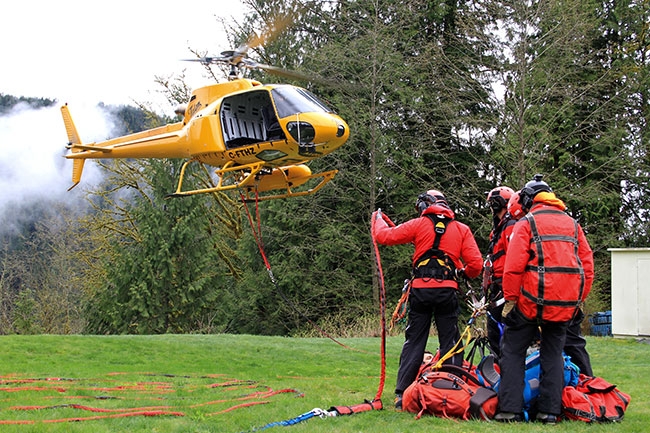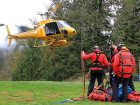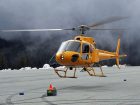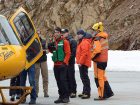
Features
Commercial
SAR
A Mountainous Undertaking
July 10, 2017 By Paul Dixon
Tourism and outdoor recreation have become major drivers in B.C.’s economy and continue to grow every year.
 NSR HECS techs on annual training with the Boost System in Bone Creek Tourism and outdoor recreation have become major drivers in B.C.’s economy and continue to grow every year.
NSR HECS techs on annual training with the Boost System in Bone Creek Tourism and outdoor recreation have become major drivers in B.C.’s economy and continue to grow every year.As B.C.’s traditional resource-based economy has waned, the tourism sector has expanded into a four-season industry, attracting millions of visitors and residents to get out and explore the great outdoors across the province. However, fun in the outdoors can quickly become trouble and the growth in outdoor recreation has also seen a growth spurt in search and rescue (SAR) incidents province-wide.
In B.C., there are more than 2,500 volunteers in 80 community-based teams that respond for SAR and the numbers reveal that they’ve been pretty busy. Over the past few years, there has been a marked increase in the number of SAR calls in the province. For example, in 2013, B.C. had some 1,067 SAR calls, while that number jumped for well over 2,000 last year, according to the Emergency Management BC, the provincial agency that oversees volunteer SAR teams in the province.
In most areas of B.C., the outdoors is literally staring you in the face and no more so than the southwestern corner that stretches from the Fraser Valley in the east, through Metro Vancouver and up the Sea To Sky Corridor to Whistler and beyond. When you look at the mountains of Vancouver’s North Shore on a bright, sunny day they look even closer and more inviting than in tourist brochures.
It’s often said that you can leave your hotel or office in downtown Vancouver and be on the ski slopes or in a mountain meadow in a matter of minutes. It’s true and you have your choice of three different mountains to choose from – Cypress (home to the 2010 Winter Olympic freestyle skiing events), Grouse or Seymour. What is deceiving to so many is that once you get yourself to the mountain, far too many people are not mentally or physically prepared for the trip they set out on, no matter what the season.
Peter Murray of Talon Helicopters has spent a lot of time flying in support of SAR teams in southwestern B.C. and he maintains it’s a simple matter of the more people that are attracted to the outdoors means more people getting in trouble.
“Despite all the information and all the signage,” he says, “people are still naïve about the mountains, they just have no idea. You look at the mountains from the south [view from downtown Vancouver] and they seem so gentle, but once you get into them it can be very treacherous.”
This past year, winter arrived early and stayed late. Two of the ski hills on Vancouver’s North Shore, Cypress Mountain and Grouse Mountain, didn’t shut down until the 2017 Victoria Day weekend. Even well into June, there was three feet of snow down to the parking lots at Cypress and Mount Seymour on the other end of the North Shore. For Murray, it meant taking part in many more SAR calls.
“This winter had a lot of snow, it lasted a long time,” he told Helicopters. “Our winter-style SAR calls are extending late into spring. There are more injuries, even on simple hikes, where people need to be flown out.”
While the three ski resorts are privately operated and have maintain ski patrol operations for their own areas of responsibility, there is an extensive backcountry area behind the resort areas within provincial and regional parks that attracts legions of snowshoe enthusiasts and backcountry skiers. For North Shore Rescue (NSR), the early arrival of winter saw a spike in calls as a series of storms produced more snow than people anticipated. Mike Danks, NSR team leader, says this resulted in people being overwhelmed by the snow.
“People weren’t able to navigate in whiteout conditions, they were overwhelmed by the snowpack conditions and the avalanche danger,” he says. “We had a number of situations where people were actually involved in smaller avalanches.” Finding themselves confronted by the imminent threat of an avalanche is unsettling for even the most experienced backcountry types. People panic and their decision-making ability suffers, which generally means heading into even more treacherous terrain.”
A Fearsome Foe
Tony Baker Gully at Cypress Mountain is named after a young man who died there 30 years ago. It has earned a fearsome reputation. Tony Baker was a 14-year old boy who took a wrong turn at the top of the mountain and went down the gully that now bears his name. In early December 2016, NSR had to retrieve two out-of-bounds skiers from Tony Baker Gully.
“Two men in their early ’40s,” recalls Danks, “ducked under the ropes for a couple of quick turns, but the moment they went under the rope they triggered an avalanche that carried them down quite a distance.” While they weren’t buried, they were scared and poor decision-making compounded their problem.
“They kept going further down into the gully,” says Danks, “until they couldn’t move any further. They couldn’t go up or down. They were soaking wet and they spent a really chilly night because we could not send members into that avalanche danger.” The next morning, the weather cooperated and NSR was able to reach the two and working with Talon extracted them using a longline.
In March 2017, two backcountry skiers, described by Danks as “very experienced,” were hit by an avalanche in Tony Baker Gully and carried more than 100 metres downhill to the edge of large cliff. One was buried under 10 feet of snow. “They would have died,” Danks told media at the time, “had they not been properly trained and carrying safety gear.”
The two men were fortunate that a second group of five backcountry skiers saw what happened and made their way down, dug out the victim and administered care until the SAR teams arrived. The badly injured skier was packaged and loaded onto a Talon helicopter, but instead of flying to the resort parking lot and transferring to a ground ambulance for the long ride to the hospital, the helicopter flew the patent directly to a park adjacent to Lions Gate Hospital.
Overcoming Harsh Realities
Not all incidents have happy endings. The NSR spent the week between Christmas and New Year’s in 2016 searching Cypress for two missing snowshoers. Their car was found in the Cypress parking lot at the end of the day on Christmas Day. When the search began the next morning, there was no indication as to what route the experienced backcountry snowshoers might have taken in an area that includes several mountains and many miles of backcountry trails. Weather hampered the search until the end of the week, when it cleared enough to allow two helicopters to search the most likely areas.
“We didn’t see any sign of these guys,” said Danks, at the time. “With the amount of snowfall that we had over the period that they were missing, the high avalanche danger and the low ceiling with the clouds, it was a very challenging search.” The search was eventually called off after a week and the missing men have yet to be found.
In early April 2017, five snowshoers died when a cornice collapsed beneath them on Mount Harvey, to the north of Cypress Mountain above Lions Bay on the Sea To Sky corridor. Six experienced and well-equipped hikers had set out on the established trail in what were described as extreme winter conditions. One of the hikers fell behind the group and when he reached the summit of Mount Harvey, expecting to see his friends, it quickly became apparent what had happened. The hiker saw that tracks leading to a point where there was a sheer break in the snow where there had been a cornice.
In a statement at the time, Martin Colwell, leader of Lions Bay SAR noted, “It appears these people stepped onto that cornice, which is unsupported snow, especially with the heavy snow and wind we’ve had, and it broke, sheered off and they fell to the base of Mount Harvey.” A total of 86 SAR members from Lions Bay, North Shore Rescue, Coquitlam, Pemberton, Whistler, Surrey and Central Fraser Valley responded – along with two helicopters – but searchers were unable to access the area at the bottom of the mountain until daybreak the next day due to the high risk of avalanche.
Changing Conditions
A barometer of mountain conditions on Vancouver’s North Shore as spring arrives is the opening of the Grouse Grind, the challenging trail up the face of Grouse Mountain known affectionately as Mother Nature’s Stairmaster. As has been the case in most years, the trail officially opens in April or early May. But 2017 saw the opening delayed until June 17 due to the snowpack and icy conditions at the upper end.
When the Grind opens, people are deceived into thinking that it is open season on the hundreds of miles of hiking and mountain-biking trails throughout the mountains. What too many people don’t realize – as Murray mentioned – is that the Grind is on the sunny side of the mountain. Winter conditions on the backsides of the mountains and in the many steep valleys that separate the mountains can persist well into late summer. It can be a beautiful warm sunny day, but all too often hikers discover that back in the mountains, the shadows can be long and dark as the sun disappears and temperatures drop rapidly.
Murray grew up on the North Shore and spent his childhood on those trails. He is well aware of the inconsistent environmental conditions of that location. “It can be misleading,” he says. “When people set out on a trail. It seems so tame, but they don’t realize it’s a wild forest. Then the temperature starts to drop and they get turned around . . . then they’re lost.”
Murray doesn’t keep track of the reasons that lead people to get lost or injured in this area of the province, he just concentrates on finding them and getting them out. “There are so many different people,” he says, “and so many different reasons. The reality is there are hundreds that go up there unprepared and nothing happens. It’s not a sure thing, it’s just that the more people you have go up there like that, the greater chance that you will have something happen.”
The warnings and advisories about the inherent dangers of going into the outdoors are plentiful. There are signs on roads, large postings in parking lots and at trailheads. It takes a conscious effort to ignore those advisories and set out unprepared, yet thousands of people do so every year. “It’s kind of crazy,” Danks says. “It’s inexperienced and not physically fit people going out and trying hikes that aren’t easy hikes.”
Michael Coyle, search manager with Coquitlam SAR, reports a similar sentiment. As the days get longer, people are lured into the outdoors, but they don’t read the fine print on their maps or they rely on social media or apps for directions. They see what appears to be a relatively simple three- or four-hour walk, but they don’t understand that that a journey involves a significant elevation gain. They set out too late in the afternoon and get caught out in the darkness without a flashlight or warm clothing. And then suddenly, a twisted ankle can become a major problem. Coquitlam and NSR report both dealt with a number of similar incidents in late May and early June.
A Pathway to Education
On May 27, NSR held a full-day training session on Mount Seymour for new members, specializing on avalanche beacon search techniques, rock climbing and rappelling as well as first aid. The team also held a staged briefing that drew a full turnout of local media to acknowledge a significant contribution from the TB Vets organization as well as to demonstrate some of the emergency medical equipment they deploy in the field – a Zoll X Series Monitor/Defibrillator along with their Zoll Autopulse and Oxylator ventilator.
The demonstration included packaging their mock patient for transport and loading them onto a waiting Talon helicopter. Late in the afternoon, as they were wrapping up on Mount Seymour, NSR was paged out for two unrelated instances of lost/injured hikers.
For Coquitlam SAR, the first weekend in June saw some members spend both days participating in a UAV evaluation (Coquitlam is one of two teams in the province participating in a study of UAVs funded by EMBC), while other team members were involved in training exercises. At the end of the day, they were paged out to find three teenagers who were lost in the Coquitlam Lake area. Again, the teens were unprepared, unequipped and poorly dressed. The following weekend, Coquitlam was paged out on the Saturday evening after a full day spent at a fund-raising BBQ.
The ground search and rescue teams in B.C. are 100 per cent volunteer, of which they are fiercely proud. And while the rescue missions certainly garner media attention, the lion’s share of their time is spent in training, certifying a wide range of disciplines and above all, fundraising. This money comes from a wide range of sources. Funding comes from the provincial government as well as regional district and municipalities. Then there is grant writing, as well as making applications and presentations to local service clubs.
In the end, it’s a multi-prong, complicated process and with more and more people converging on B.C.’s diverse outdoor opportunities, it will indeed be up to operators like Talon, Valley Helicopters, Blackcomb and more to ensure the province’s weekend warriors return safely at night.



